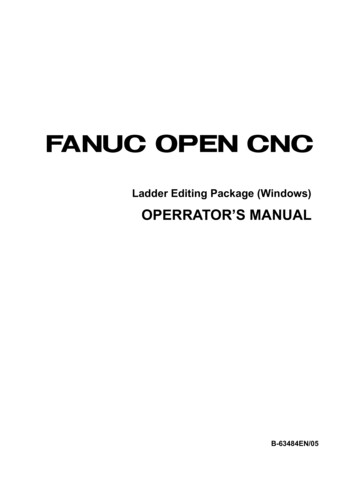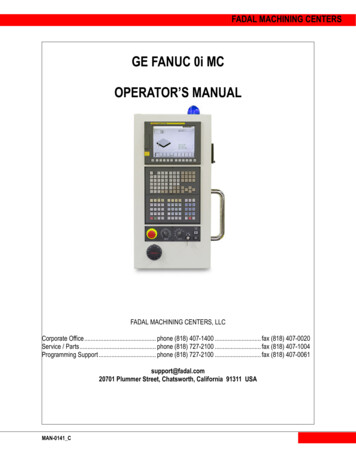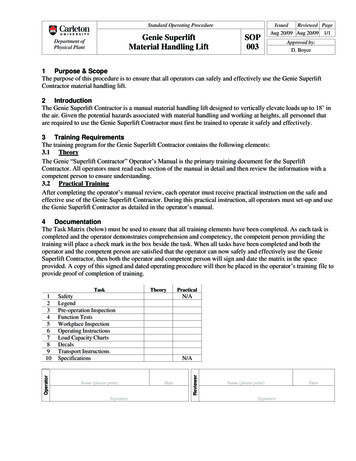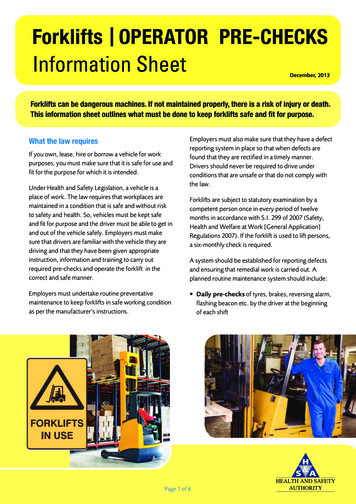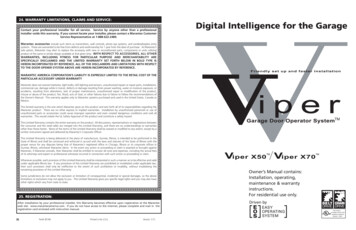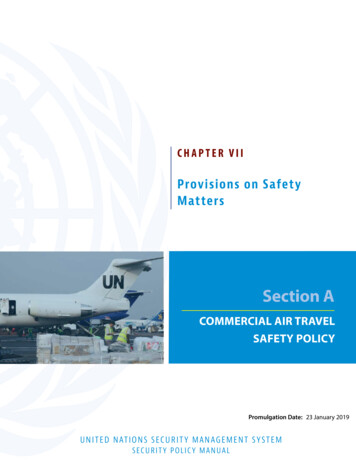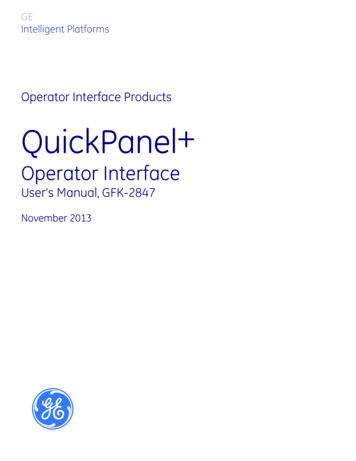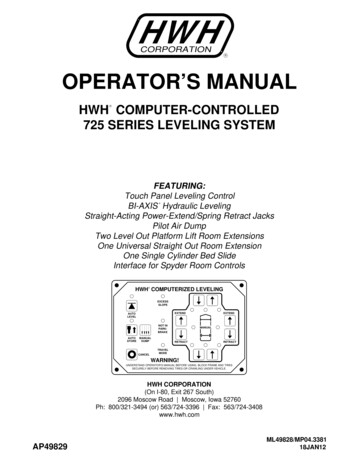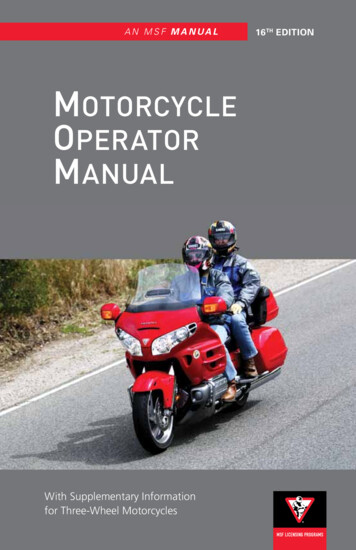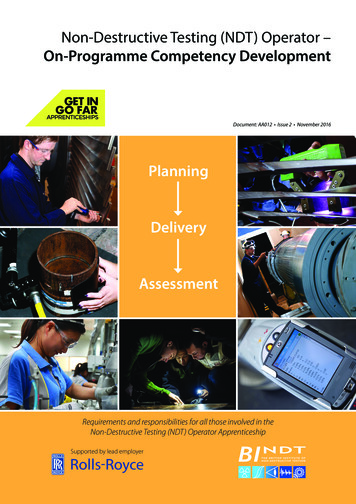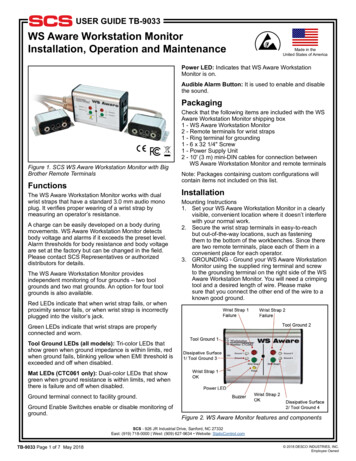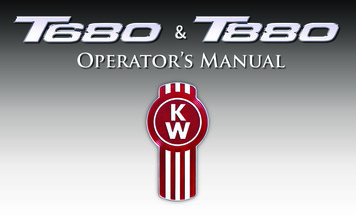
Transcription
&Operator’s Manual
nce5Information6Index7
Contents 2013 Paccar Inc - All Rights ReservedThis manual illustrates and describes the operation of features or equipment which may be either standard or optional onthis vehicle. This manual may also include a description of features and equipment which are no longer available or werenot ordered on this vehicle. Please disregard any illustrations or descriptions relating to features or equipment which arenot on this vehicle.PACCAR reserves the right to discontinue, change specifications, or change the design of its vehicles at any time withoutnotice and without incurring any obligation.The information contained in this manual is proprietary to PACCAR. Reproduction, in whole or in part, by any means is strictlyprohibited without prior written authorization from PACCAR Inc.
Truck Model Examplei
SAFETY1INTRODUCTIONAbout the Manual . . . . . . .Safety Alerts . . . . . . . . .Vehicle Safety . . . . . . . .A Special Word About Repairs .Additional Sources of Information.1-31-31-51-71-8.1-101-111-121-13Hood Hold Downs. . . . . . . . . . . . . . .Hood Tilt . . . . . . . . . . . . . . . . . . .Hood Hold-Open Device . . . . . . . . . . . .1-151-161-17CAB AND FRAME ACCESSSafety . . . . . . . . . . .Door Lock and Keys. . . . .Remote Keyless Entry (RKE) .Climbing onto the Deck Plate .GETTING TO YOUR ENGINE(04/13)Y53-1200-1B11-1
SAFETYSEATS AND RESTRAINTS1Introduction . . . . . . . .Safety Restraint Belts . . . .Tether Belts . . . . . . . .Komfort-Latch Feature . . .During Pregnancy. . . . . .Belt Damage and Repair . . .Sleeper Bunks and RestraintsSafety Restraint Tips . . . 1-36START-UPIntroduction . . . . .Safe Vehicle OperationVehicle Loading. . . .Emergency EquipmentDriver's Check List . .1-2.Y53-1200-1B1(04/13)
INTRODUCTIONINTRODUCTIONAbout the ManualCongratulations! Your selection of aKenworth truck was a wise investment.Kenworth trucks are recognized asthe industry standard for quality andreliability.Please take the time to get acquaintedwith your vehicle by reading thisOperator’s Manual. We recommendthat you read and understand thismanual from beginning to end beforeyou operate your truck. This manualexplains the safe, efficient operationand maintenance of your Kenworth.Safety AlertsYour Kenworth may not have all thefeatures or options mentioned in thismanual. Therefore, you should paycareful attention to the instructions thatpertain to just your vehicle. In addition,if your vehicle is equipped with specialequipment or options not discussed inthis manual, consult your dealer or themanufacturer of the equipment.All information contained in thismanual is based on the latestproduction information available at thetime of publication. Kenworth TruckCompany reserves the right to makechanges at any time without notice.1Please read and follow all of thesafety alerts contained in this manual.They are there for your protectionand information. These alerts canhelp you avoid injury to yourself, yourpassengers, and help prevent costlydamage to the vehicle. Safety alertsare highlighted by safety alert symbolsand signal words such as "WARNING","CAUTION", or "NOTE". Please do notignore any of these alerts.NOTEAfter you’ve read this manual, it shouldbe stored in the cab for convenientreference and remain with this truckwhen sold.(04/13)Y53-1200-1B11-3
INTRODUCTION1WARNINGCAUTIONExample:WARNING!The safety message following thissymbol and signal word provides awarning against operating procedureswhich could cause death or personalinjury. They could also causeequipment or property damage. Thealert will identify the hazard, how toavoid it, and the probable consequenceof not avoiding the hazard.CAUTIONWARNING!Do not carry additional fuel containersin your vehicle. Fuel containers, eitherfull or empty, may leak, explode, andcause or feed a fire. Do not carry extra fuel containers. Even empty onesare dangerous. Failure to comply mayresult in death or personal injury.The safety alert following this symboland signal word provides a cautionagainst operating procedures whichcould cause equipment or propertydamage. The alert will identify thehazard, how to avoid it, and theprobable consequence of not avoidingthe hazard.Example:CAUTIONContinuing to operate your vehiclewith insufficient oil pressure will causeserious engine damage. Failure tocomply may result in equipment orproperty damage.1-4Y53-1200-1B1(04/13)
INTRODUCTIONVehicle SafetyNOTENOTEThe alert following this symbol andsignal word provides importantinformation that is not safety relatedbut should be followed. The alertwill highlight things that may not beobvious and is useful to your efficientoperation of the vehicle.WARNING!Do not drink alcohol and drive. Yourreflexes, perceptions, and judgmentcan be affected by even a smallamount of alcohol. You could have aserious or even fatal accident, if youdrive after drinking. Please do notdrink and drive or ride with a driverwho has been drinking. Failure tocomply may result in death, personalinjury, equipment or property damage.WARNING!Every new vehicle is designed toconform to all Federal Motor VehicleSafety Standards applicable at the timeof manufacture. Even with these safetyfeatures, continued safe and reliableoperation depends greatly uponregular vehicle maintenance. Followthe maintenance recommendationsfound in Preventive Maintenance onpage 5-9. This will help preserve yourinvestment.Do not text and drive. Your reactiontime, perceptions and judgment canbe affected while texting or using anyother form of mobile messaging whiledriving. Failure to comply may resultin death, personal injury, equipment orproperty damage.Keep in mind that even a wellmaintained vehicle must be operatedwithin the range of its mechanicalcapabilities and the limits of its loadratings. See the Weight Ratings labelon the driver's door edge.Example:NOTEPumping the accelerator will not assistin starting the engine.Make sure your vehicle is in topworking condition before heading(04/13)out on the road, it is the responsibledriver's duty to do so. Inspect thevehicle according to the Driver's CheckList beginning on page 1-36.Y53-1200-1B1Safe driving is only possible with theproper concentration on the driving1-51
INTRODUCTION1task. Keep distraction to a minimum toimprove your concentration. Examplesof distractions may include radiocontrols, GPS navigation controls,cellular telephone calls, cellular textmessages, reading or reaching forsomething on the floor. Minimizingyour distractions will improve safedriving and will help avoid an accidentinvolving death or personal injury.Be aware of local regulations that mayprohibit the use of cellular telephoneswhile driving. In addition to being anunsafe practice, it may be against localor federal ordinances to use cellulardevices while operating the vehicle.This manual is not a training manual.It cannot tell you everything you needto know about driving your vehicle. Forthat you need a good training programor truck driving school. If you have notbeen trained, get the proper trainingbefore you drive. Only qualified driversshould drive this vehicle.1-6California Proposition 65 WarningData Recorder California Vehicle Code - Section9951- Disclosure of Recording DeviceDiesel engine exhaust and someof its constituents are known tothe State of California to causecancer, birth defects, and otherreproductive harm. Other chemicals in this vehicleare also known to the State ofCalifornia to cause cancer, birthdefects or other reproductiveharm. Battery posts, terminals, andrelated accessories contain leadand lead compounds, chemicalsknown to the State of Californiato cause cancer and reproductiveharm. Wash hands after handling.Y53-1200-1B1Your vehicle may be equipped with oneor more recording devices commonlyreferred to as “event data recorders(EDR)” or “sensing and diagnosticmodules (SDM)”. If you are involved inan accident, the device(s) may havethe ability to record vehicle data thatoccurred just prior to and/or during theaccident. For additional information onyour rights associated with the use ofthis data, contact the California Department of MotorVehicles - Licensing OperationsDivision– or – http://www.dmv.ca.gov/(04/13)
INTRODUCTIONEnvironmental Protectionfor information concerning properdisposal.WARNING!1WARNING!Diesel engine exhaust and some of itsconstituents are known to the Stateof California to cause cancer, birthdefects, and other reproductive harm.Other chemicals in this vehicle arealso known to the State of Californiato cause cancer, birth defects or otherreproductive harm. This warning requirement is mandated by Californialaw (Proposition 65) and does not result from any change in the manner inwhich vehicles are manufactured.Do not attempt repair work without sufficient training, service manuals, andthe proper tools. You could be killedor injured, or you could make your vehicle unsafe. Do only those tasks youare fully qualified to do.Your dealer’s service center is the bestplace to have your vehicle repaired.You can find dealers all over thecountry with the equipment and trainedpersonnel to get you back on the roadquickly—and keep you there.Some of the ingredients in engineoil, hydraulic oil, transmission andaxle oil, engine coolant, diesel fuel,air conditioning refrigerant (R12,R134a, and PAG oil), batteries, etc.,may contaminate the environment ifspilled or not disposed of properly.Contact your local government agency(04/13)A Special Word AboutRepairsYour vehicle is a complex machine.Anyone attempting repairs on it needsgood mechanical training and theproper tools. If you are sure youhave these requirements, then youcan probably perform some repairsyourself. However, all warranty repairsY53-1200-1B11-7
INTRODUCTION1must be performed by an authorizedservice facility. If you aren’t anexperienced mechanic, or don’t havethe right equipment, please leave allrepairs to an authorized service facility.They are the ones equipped to do thejob safely and correctly.Maintenance Manuals. If you dodecide to do any complex repair work,you’ll need the maintenance manuals.Order them from your authorizeddealer. Please provide your ChassisSerial Number when you order, to besure you get the correct manuals foryour vehicle. Allow about four weeksfor delivery. There will be a charge forthese manuals.WARNING!Modifying your vehicle can make it unsafe. Some modifications can affectyour vehicle's electrical system, stability, or other important functions. Before modifying your vehicle, check withyour dealer to make sure it can bedone safely. Improper modificationscan cause death or personal injury.Additional Sources ofInformationInstalled Equipment - Operator'sManualsMajor component suppliers also supplyoperation manuals specific to theirproducts. Additional manuals andother pieces of literature are includedin the glove box literature package.Look for information on productssuch as the engine, driver's seat,transmission, axles, wheels, tires,ABS/ESP (if applicable), radio, 5thwheel, lane departure and adaptivecruise control. If you are missing thesepieces of literature, ask your Dealerfor copies.Final Chassis Bill of Material. Acomplete, non-illustrated computerprintout listing of the parts used tocustom-build your vehicle is availablethrough the dealer from whom youpurchased your vehicle.1-8Y53-1200-1B1(04/13)
INTRODUCTIONOther Sources1Another place to learn more abouttrucking is from local truck drivingschools. Contact one near you to learnabout courses they offer.Federal and state agencies suchas the department of licensing alsohave information. The InterstateCommerce Commission can giveyou information about regulationsgoverning transportation across statelines.(04/13)Y53-1200-1B11-9
CAB AND FRAME ACCESS1CAB AND FRAMEACCESSSafetyWARNING!Always reinstall steps before enteringthe cab or accessing the deck plate.Without steps you could slip and fall.Failure to comply may result in deathor personal injury.Be careful whenever you get into or outof your vehicle’s cab. Always maintainat least three points of contact withyour hands on the grab handles andyour feet on the steps.1-10WARNING!Jumping out of the cab or getting intothe cab without proper caution is dangerous. You could slip and fall, whichcould lead to death or personal injury.Keep steps clean. Clean any fuel, oil,or grease off of the steps before entering the cab. Use the steps and grabhandles provided, and always keep atleast three points of contact betweenyour hands and feet and the truck. Always face toward the vehicle whenentering or exiting the cab and lookwhere you are going.The following picture shows the bestway to enter and exit a ConventionalCab.Y53-1200-1B1(04/13)
CAB AND FRAME ACCESSDoor Lock and KeysDoor LockDoors can be locked from the inside byusing the lock button. Close the doorthen push the button down to lock.Doors automatically unlock when youopen them from inside, and can belocked from the outside with the key orthe optional remote keyless entry keyfob.KeysTo lock or unlock the doors fromoutside the cab, insert the key in thelock. Turn the key toward the rear tolock; forward to unlock.1The same key fits your ignition, doors,and sleeper luggage compartment.Frame-mounted tool box locks andlocking fuel tank caps each haveindividual keys.WARNING!To reduce the chance of death or personal injury, always lock the doorswhile driving. Along with using the lapshoulder belts properly, locking thedoors helps prevent doors from inadvertently opening and occupants frombeing ejected from the vehicle.(04/13)Y53-1200-1B11-11
CAB AND FRAME ACCESS1Remote Keyless Entry (RKE)(Optional)This vehicle may be equipped with aRemote Keyless Entry (RKE) systemthat adds security and convenienceto your vehicle. The system willlock or unlock the driver’s door andpassenger’s door with the key fob andalert you with parking lights when theselected doors are locked or unlocked.The system includes two key fobs thatprovide secure rolling code technologythat prevents someone from recordingthe entry signal.1-12NOTEFCC ID: L2C0031T IC: 3432A-0031TFCC ID: L2C0032R IC: 3432A-0032RThis device complies with Part 15 ofthe FCC Rules and with RSS-210 ofIndustry Canada.Operation is subject to the followingtwo conditions:(1) This device may not cause harmfulinterference, and(2) This device must accept any interference received, including interference that may cause undesired operation.Changes or modifications not expressively approved by the party responsible for compliance could void theuser's authority to operate the equipment. The term “IC:” before the radiocertification number only signifies thatIndustry Canada technical specifications were met.Y53-1200-1B1OperationTo Unlock the Driver’s DoorPress the UNLOCK button once. Thedriver's door will unlock and the parkinglights will come on for 40 seconds.To Unlock the Passenger’s DoorPress the UNLOCK button once andpress again within 5 seconds. Thepassenger door will unlock.To Lock All DoorsPress the LOCK button. The doors willlock and the parking lights will comeon for 2 seconds. If the doors are openthey will not lock. The range of theRKE system should be approximately30 ft. This will be reduced if it isoperated close to other RF sourcessuch as TV/radio transmitters and celltowers.(04/13)
CAB AND FRAME ACCESSBatteriesSynchronizationThe key fob uses one CR2032,3V battery. Batteries should lastapproximately three years, dependingon use. Consistently reduced rangeis an indicator that the battery needsreplacement. Batteries are availableat most discount, hardware, and drugstores.The key fob may need to besynchronized to the truck when thebattery is replaced or when the key fobhas not been used for an extendedperiod of time.The battery can be accessed byremoving the cover of the key fob.After a new battery is installed, thekey fob must be synchronized with thevehicle.(04/13)To Synchronize A Key Fob:1.Hold the key fob near the receiverwhich is located behind thespeedometer and tachometer.2.Press and hold both the Lock andUnlock buttons at the same timefor approximately 7 seconds.3.When the key fob isresynchronized, the doorswill lock then immediately unlock.4.If the fob fails to synchronize,it could be programmed to adifferent truck or could have failed.Contact your dealer to re-programyour key fob.Y53-1200-1B1Climbing onto the DeckPlate1WARNING!When you are climbing onto and offthe deck plate, maintain at least threepoints of contact with your hands onthe grab handles and your feet on thesteps. Always face toward the vehiclewhen entering or exiting the cab andlook where you are going. Failure tocomply may result in death or personalinjury.WARNING!When stepping onto a surface to enterthe cab or access the deck plate, onlyuse the steps and grab handles installed and designed for that purpose.Failure to use the proper steps andgrabhandles could cause a fall whichmay result in death or personal injury.1-13
CAB AND FRAME ACCESS1WARNING!Keep steps clean. Clean any fuel,oil, or grease off the steps before entering the cab or accessing the deckplate. Stepping on a slippery surfacecan cause a fall which may result indeath or personal injury.The following pictures show you theright way to get on and off the areabehind your cab.WARNING!Always reinstall steps before enteringthe cab or accessing the deck plate.Without steps you could slip and fall.Failure to comply may result in deathor personal injury.NOTEAny alteration (adding bulkheads,headache racks, tool boxes, etc.) behind the cab that affects the utilizationof installed grab handles, deck plates,or frame access steps should comply with Federal Motor Carrier SafetyRegulation 399.1-14Maintain three points of contact.Hold handles as you step up.Y53-1200-1B1(04/13)
GETTING TO YOUR ENGINEGETTING TO YOURENGINE1. Hood Latch in the Closed PositionHood Hold DownsHood hold downs keep a hood fromopening unexpectedly.CAUTIONA hood not latched securely couldopen during operation and cause vehicle damage. Be sure to latch thehood securely.(04/13)Y53-1200-1B11-151
GETTING TO YOUR ENGINE1Hood Tilt2. Pull Latch to Open3. Pull Up to SeparateTo open your hood, unlock the hoodhold downs by unlatching them. Putone or both hands on the top of thehood front. Tilt the hood forward bypulling at the top of the hood, pivotingon the foot placed on the bumperand using the foot on the ground forstability. Keep pulling on the hooduntil you are certain that the hood holdopen device is engaged. When closingthe hood, be sure that you maintainthe same points of contact (top of hoodand bumper) to control the movementof the hood as it closes.WARNING!A pivoting hood could hurt someone orbe damaged itself. Before opening orclosing the hood, be sure there are nopeople or objects in the way. Failure tostand in a position of safety can causedeath or personal injury.1-16Y53-1200-1B1(04/13)
GETTING TO YOUR ENGINEHood Hold-Open DeviceThe hood is equipped with a hoodhold-open device. In order for the hoodhold-open device to become engaged,the vehicle hood must be fully open.Once the vehicle hood is fully open,the hold-open latch will automaticallyengage and will need to be disengagedby the operator.The release lever for the hood holdopen device is located near the fronthinge of the hood. Press the lever in todisengage the hood hold open device.Pull with hand from herePress in to disengage(04/13)Y53-1200-1B11-171
GETTING TO YOUR ENGINE1WARNING!Before opening or closing the hood,make sure your footing is secure andstable. Failure to do so may causethe hood to close uncontrollably whichmay result in death or personal injury.WARNING!Always ensure the hood hold-openlatch is engaged to keep the hood fullyopen any time anyone gets under thehood for any reason. Failure to do somay cause the hood to close uncontrollably which may result in death orpersonal injury.WARNING!Before closing the hood, be sure thearea is clear—no people or objects arein the way. Failure to do so may resultin death or personal injury.1-18Y53-1200-1B1(04/13)
SEATS AND RESTRAINTSSEATS ANDRESTRAINTSSeat AdjustmentIntroductionDo not adjust the driver's seat whilethe vehicle is moving. The seat couldmove suddenly and unexpectedly andcan cause the driver to lose control ofthe vehicle. Make all adjustments tothe seat while the vehicle is stopped.After adjusting the seat and beforedriving off, always check to ensure thatthe seat is firmly latched in position.Failure to comply may result in death,personal injury or property damage.This section covers the operationand safe use of your seats. Forfurther information on features andadjustment of the seat, see themanufacturer's Service and OperationManual included with the vehicle.Suggested Control Setting Order:WARNING!WARNING!Before driving or riding in vehicle,ensure that there is adequate headclearance at maximum upward travelof seat. Injury may occur if headclearance is not adequate. Failure tocomply may result in death or personalinjury.(04/13)Y53-1200-1B11.Seat fore/aft position2.Seat height3.Thigh support4.Seat bottom angle5.Seat back recline angle6.Lumbar7.Adjust steering wheel8.Adjust mirrorsThe suspension seat in this vehicle willhave the following controls to adjustthe seat to the operator’s specificneeds.1-191
SEATS AND RESTRAINTS1WARNING!Seat heaters should not be used if theoperator or passenger has difficulty insensing and reacting to an increasedtemperature of the seat. The heaterfunction may result in personal injury.CAUTIONDo not use the seat heater for morethan 10 minutes at one time. Alwaysturn off the seat heaters when theyare not needed. Overuse of the seatheater may decrease the capacity ofthe vehicle’s batteries and may resultin poor starting and potential equipment damage.1. Seat fore/aft2. Express down3. Suspension stiffness4. Seat height up/down5. Lumbar and bolster* controls6. Recline adjustment7. Armrest angle adjustment*This is an optional feature and may varydepending on the vehicle.1. Seat heater/cooler2. Seat thigh support up/down3. Seat bottom angle adjustment1-20Y53-1200-1B1(04/13)
SEATS AND RESTRAINTS1WARNING!Do not drive or ride with your seat backin the reclined position. You could beinjured by sliding under the seat beltsin a collision. Failure to comply mayresult in death or personal injury.Lumbar (and bolster support ifavailable) are provided for superiorsupport to the back during operation.Lower support is standard and theoptional functions include upperlumbar and bolster functions. Pressingon the “ ” symbol of the button willadd support in the area. Pressing theopposite side of the button will releasepressure and will reduce support in thearea.(04/13)1. Lower and Upper* lumbar adjustment2. Bolster* adjustment*This is an optional feature and may varydepending on the vehicle.The seats in this vehicle are equippedwith a switch that locks out the fore-aftisolator function in the seat. Whenlocked, the seat will not move backand forth. It will be rigidly fixed andonly allowed to move up and downwith the vehicle’s movements.Y53-1200-1B11-21
SEATS AND RESTRAINTS1Safety Restraint BeltsPassenger Seat Swivel (Optional)WARNING!This vehicle may be equipped with aswivel function on the passenger seat.This function allows the passengerseat to rotate and face towards theinside of the cab.WARNING!Always ensure that the passengerseat is locked into the forward-facingposition when the vehicle is in motion. Locking the swivel seat into theforward facing position maximizes visibility to the surrounding area. Failureto comply creates a safety hazard thatmay result in death or personal injury.1-22Do not use the swivel function while apassenger is in the seat and the vehicle is in motion. The seat belt will notprovide proper protection if the passenger is not facing forward and thevehicle is in an accident. Failure tocomply may result in death or personalinjury.Safety belts have proven to be thesingle most effective means availablefor reducing the potential for eitherdeath or personal injury in motorvehicle accidents. Unbelted riderscould be thrown into the windshieldor other parts of the cab or could bethrown out of the cab. They couldstrike another person. Injuries can beY53-1200-1B1(04/13)
SEATS AND RESTRAINTSmuch worse when riders are unbelted.Always fasten your seat belt and besure anyone riding with you does thesame. Therefore, read the followinginstructions and always observe userwarnings pertaining to safety belts.above the speedometer/tachometer(see “Seat Belt, Fasten” on page 3-41).1The combination lap-shoulder belt isequipped with a locking mechanism.The system adjusts automatically to aperson's size and movements as longas the pull on the belt is slow.WARNING!Hard braking or a collision locks thebelt. The belt will also lock whendriving up or down a steep hill or in asharp curve.Do not drive vehicle without your seatbelt and your riders belts fastened.Riding without a safety belt properlyfastened can lead to death or personalinjury in an emergency.To fasten the belt:WARNING!In vehicles equipped with passengerseat swivel function, the seat belts willonly perform their intended functionwhen the seat is facing forward. Failure to comply can lead to death or personal injury in an emergency.Your vehicle is equipped with a seat beltindicator in the warning light display(04/13)Lap/Shoulder BeltY53-1200-1B11.Grasp the belt tongue.2.Pull belt in a continuous slowmotion across your chest and lap.3.Insert belt tongue into buckle oninboard side of seat.4.Push down until the tongue issecurely locked with an audibleclick.1-23
SEATS AND RESTRAINTS15.Pull belt to check for properfastening and adjustment, asfollows: Pull shoulder section to make surebelt fits snugly across the chestand pelvis. There should be less than 1 inch(25 mm) gap between the bodyand the belt. The shoulder belt must bepositioned over the shoulder, itmust never rest against the neckor be worn under the arm. Make sure any slack is wound upon the retractor and that the beltis not twisted.If the belt is locked, lean the body backto remove any tension in the belt. Afterreleasing the belt, allow the belt toretract completely by guiding the belttongue until the belt comes to a stop.To unfasten the belt:1.Push in the release button on thebuckle.2.The belt will spring out of thebuckle.1-24Y53-1200-1B1(04/13)
SEATS AND RESTRAINTS1Safety Restraint BeltsLap BeltCorrectIncorrect (too high on hips)WARNING!Proper seat belt adjustment and useis important to maximize occupantsafety. Failure to wear or adjust thesafety belt properly may result in deathor personal injury.(04/13)Shoulder BeltCorrect (over arm)Incorrect (under arm)Incorrect (twisted)Tether BeltsThis vehicle may have an externaltether belt installed with a seat, insteadof the internal tethering device. Tetherbelts are designed to restrain the seatin the event of a sudden stop or anaccident.Y53-1200-1B1Internal tether belts do not requireadjustment.1-25
SEATS AND RESTRAINTS1WARNING!Do not remove, modify, or replacethe tether belt system with a differenttether system. A failed or missingtether belt could allow the seat baseto fully extend in the event of an accident. Failure to comply may result indeath or personal injury.WARNING!Failure to adjust tether belts properlycan cause excessive movement ofthe seat in an accident. Tether beltsshould be adjusted so that they aretaut when the seat is in its most upward and forward position. Failure tocomply may result in death or personalinjury.1-26To adjust an external tether belt:Komfort-Latch Feature Make sure that the tether belt isattached to the cab floor and seatframe. It should be routed throughthe buckle on each side. Often the attachments are madeusing a split-type hook. Make sureboth halves of the hook are aroundthe anchor bracket.Your vehicle includes a featuredesigned to eliminate cinching andprovide improved safety and comfort.Cinching is the condition where a beltbecomes continually tighter aroundyou during a rough, bouncy ride. Theneed for this feature increases withrough road conditions, particularly overlong distances. To lengthen the tether, turn thebuckle to a right angle to thewebbing. Then pull the buckle.To shorten the tether, pull on thestrap.Y53-1200-1B1To eliminate cinching, simply activatethe Komfort-Latch feature locatedon the seat belt webbing at theappropriate time:1.Adjust the seat to its proper drivingposition.2.Latch the seat belt.3.If available, adjust the seat beltheight adjuster to a comfortabledriving position.(04/13)
SEATS AND RESTRAINTS4.While seated appropriately, pushthe "on" button to engage theKomfort Latch.5.Learn forward in the seat until youhear a "click."6.Return to normal driving position,and the Komfort Latch maintainsthe preset amount of tension relief.1WARNING!Do not set the Komfort Latch with toomuch slack. Too much slack may reduce the effectiveness of the seat belt.Failure to comply may result in deathor personal injury.To disengage the mechanism:1.Unbuckle the seat belt2.Press the “OFF” button of theKomfort Latch or tug on theshoulder strap.Komfort-Latch More information and videotutorials can be found at:http://www.clicktugsnug.com/ .(04/13)Y53-1200-1B11-27
SEATS AND RESTRAINTS1During PregnancyBelt Damage and RepairPregnant women should always wearcombination lap/shoulder belts. Thelap belt portion must be worn snuglyand as low as possible across thepelvis. To avoid pressure on theabdomen, the belt must never passover the waist. A properly worn seatbelt may significantly reduce the risksto woman and baby in the event of acrash.Damaged belts in the cab mustbe
About the Manual Congratulations! Your selection of a Kenworth truck was a wise investment. Kenworth trucks are recognized as the industry standard for quality and reliability. Please take the time to get acquainted with your vehicle by reading this Operator’s Manual. We recommend that you read and understa
